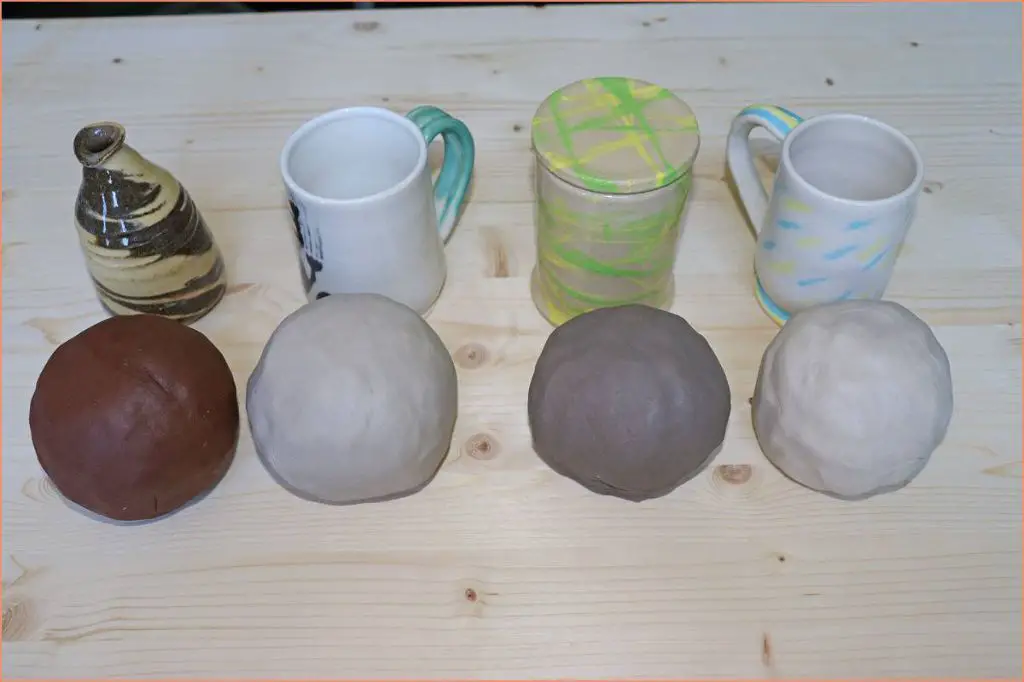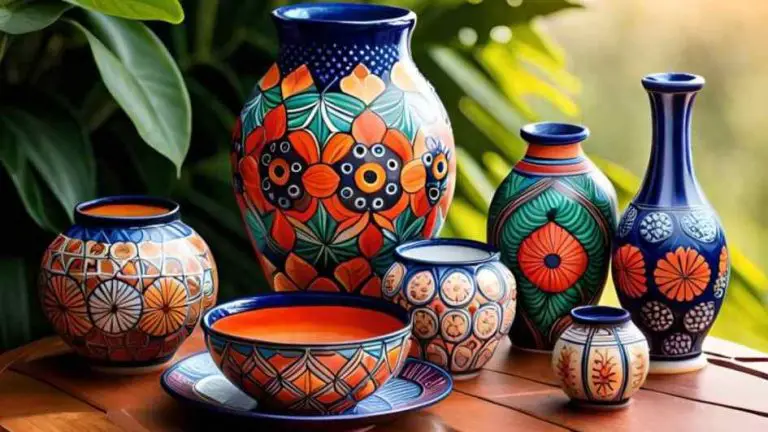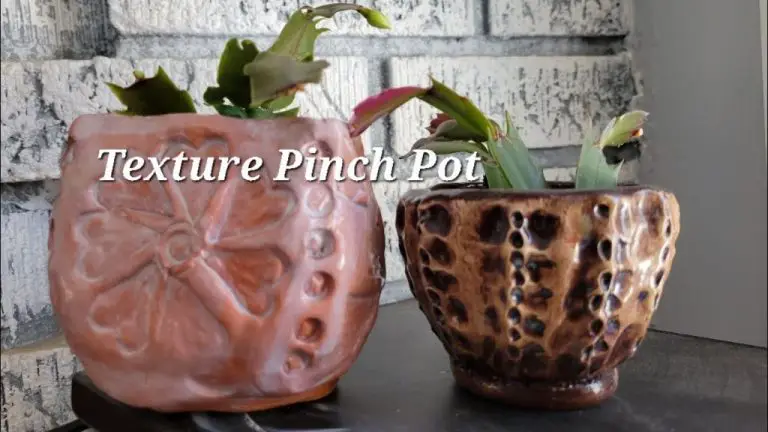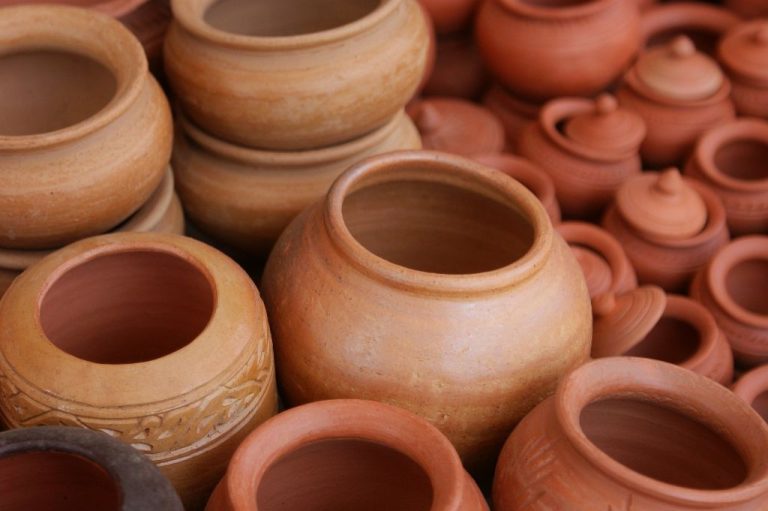Delving Into Ceramic Clays: Types And Properties
Ceramic clay is an inorganic, non-metallic material that becomes solid when fired at high temperatures. The most common types of ceramic clay bodies used in pottery are earthenware, stoneware, porcelain, ball clay, and fire clay. Each type of clay has different properties and characteristics that make them suitable for certain applications and firing temperatures.
Earthenware clays are low-fire clays that mature at lower temperatures, typically between 1700°F-2100°F. They are porous when fired and need to be glazed to make them watertight for liquid. Earthenware clays can come in various colors like red, buff, brown, and terra-cotta.
Stoneware clays are mid-range fire clays, firing between 2200°F-2400°F. They vitrify at these temperatures to become dense and non-porous, so they can be used unglazed or just lined. Stoneware clays are very strong and durable.
Porcelain clays are high-fire clays that need to be fired at very high temperatures above 2300°F. Porcelain clays are extremely fine and dense, resulting in a translucent white finish. Porcelain is known for its strength, hardness, and water resistance.
Ball clays have high plasticity and strength for shaping and modeling complex forms. Fire clays have high heat resistance and are used in insulation. Colored clays can also be added for decorative effects.
Understanding the different properties of ceramic clays allows potters to select the right type of clay body for their desired outcomes. This article will explore the most common clays used in pottery and ceramics.
Kaolin (China Clay)
Kaolin, also known as China clay, is a soft white clay that is an essential ingredient in the manufacture of porcelain and china and is widely used in the making of paper, rubber, paint, and many other products (source).
Properties: Kaolin has properties such as fine particle size, chemical inertness, whiteness, non-abrasiveness, and low electrical and thermal conductivity. It is chemically inert over a wide pH range. Kaolin particles are plate-like in shape, due to which it imparts plasticity and strength when used in the manufacturing of ceramic bodies (source).
Uses: Kaolin is used in the production of porcelain and china. It is also used in paper production as both a filler and a coating to create whiteness, opacity, printability and ink absorbency. Other industrial applications of kaolin include medicinally as a mild laxative, an ingredient in toothpaste, in paint to extend titanium dioxide (white) and for deodorizing and absorption (source).
Mined regions: Kaolin is mined in many regions globally, including Brazil, Bulgaria, France, the UK, India, and the US. The largest deposits are found in Georgia and South Carolina in the US (source). The name “kaolin” originates from the Gaoling village in China where it was first mined centuries ago.
Ball Clay
Ball clays are plastic clays that have high plasticity and strength properties, making them well suited for shaping ceramic ware. Ball clays typically contain 20-80% kaolinite, 10-25% mica, and 6-65% quartz along with some organic matter (Wikipedia, 2022). They are an essential ingredient in whiteware ceramics like porcelain and sanitaryware. The key properties of ball clays are their particle size distribution, plasticity and strength (Imerys, 2022).

Ball clays are primarily mined in the United States in regions like Kentucky, Tennessee, Texas and Oklahoma. They are an important ingredient in ceramic bodies as they help improve workability and strength. Some of the main uses of ball clays include:
- Sanitaryware – Provides strength and plasticity for shaping
- Whiteware – Gives plasticity and high fired strength
- Floor and wall tiles – Improves durability and workability
- Tableware and pottery – Adds plasticity and strength
Ball clays have very small particle sizes, with up to 80% of particles under 2 microns. This contributes to their high plasticity. They also fire to a light cream color at high temperatures. The amount of ball clay in a ceramic body can be 5-50% depending on the application.
Fire Clay
Fire clay is a type of clay that can withstand extremely high temperatures of up to 1,775°C (3,227°F)[1]. It has a high alumina content which gives it refractory properties and resistance to thermal shock. Some key properties of fire clay include:
- High fusion point due to low flux content
- Low shrinkage and plasticity
- Resistant to abrasion and chemicals
- Good insulating properties
Fire clay is ideal for creating fire bricks, refractory linings, and ceramics that need to withstand very high temperatures such as kiln furniture. It is also used to make crucibles, refractory mortars, and insulation products[2].
Fire clays are mined from residual deposits formed by the weathering of igneous and metamorphic formations. Large reserves are found across the world including the UK, USA, China, and Germany. Top producers include the US states of Missouri and Pennsylvania.
Stoneware Clay
Stoneware is a type of high-fired clay with a smooth, nonporous surface [1]. It has a partially vitrified body, denser than earthenware but less dense than porcelain [2]. This allows it to be impermeable to liquids while retaining more color variety than porcelain.
Some key properties of stoneware clay include:
- Fires to 2,200-2,300°F
- Very low porosity and absorption
- Vitrified and non-porous
- Durability and strength
- Wide range of colors and textures
Stoneware has many uses due to its durability. It is commonly used for cookware, dinnerware, decorative vases, crocks, jugs, and more [1]. The smooth, nonporous surface makes it ideal for storing liquids and food. It can withstand repeated use and washing without damage.
Stoneware’s excellent technical qualities allow it to be used not just decoratively but also functionally in a range of applications, from tableware to artisan pottery.
[1] https://digitalfire.com/glossary/stoneware
[2] https://royalbaliceladon.com/blogs/news/exploring-stoneware-characteristics-safety-and-myths-debunked
Earthenware Clay
Earthenware clay is one of the most common types of clay used in pottery. It contains a high level of impurities like iron, magnesium, calcium, and alkalis which causes it to have porous, opaque qualities after firing (The Basics of Pottery Clay, 2019).
Some key properties of earthenware clay include:
- It is relatively soft and easy to work with, making it good for handbuilding and wheel throwing
- It fires at lower temperatures, typically between 1700°F-2100°F
- It is porous and absorptive after firing
- It can come in natural earthen colors like red, brown, and buff, but also takes colored glazes well
Earthenware has a wide range of uses including tiles, pottery, tableware, sculpture, and decorative objects. Its porosity makes it suitable for use as flower pots, vases, and other items holding water. Earthenware glazes well while retaining its casual, handcrafted look (The types of pottery clay and what they are used for, n.d.). It is a popular choice for beginner potters due to its flexibility and forgiveness during throwing and handbuilding. With its versatility and accessibility, earthenware clay continues to be a staple of pottery worldwide.
Porcelain Clay
Porcelain clay is known for its white color, strength, translucency, and low porosity (Everything You Need To Know About Porcelain Clay). It has high mechanical resistance and density, which provide durability in daily use (Porcelain: A ceramic material with unique characteristics!). The clay contains kaolin or china clay, giving it plasticity and strength when fired (Stoneware Clay Vs. Porcelain Clay: Details & Facts).
Porcelain has many uses due to its hardness and low porosity. It is often used to make tableware, cookware, sanitaryware, electrical insulators, dental restorations, and decorative items like figurines. The lack of pores makes it impermeable, preventing absorption of liquids and odors. Its high strength allows thin walls and fine details. Porcelain’s white color and translucency resemble fine china. It is highly valued for a refined, elegant look.
Colored Clays
Colored clays are types of clay that contain natural mineral pigments or manmade staining agents that alter their color. They are popular for use in pottery and arts and crafts due to the visual appeal of their bright, saturated colors. Some of the most common colored clays are:
Terracotta Clay – A naturally reddish-orange clay containing iron oxide that turns red when fired. Commonly used for flower pots, garden pots, and decorative landscaping items. Terracotta has a mid-range firing temperature around 1,832°F (1,000°C). (Source: https://wheelandclay.com/blog/4-types-of-clay/)
Colored Stoneware Clays – Stoneware clays that have synthetic mineral stains added to produce colors like blue, green, purple, turquoise, etc. These are often blended to create marbled effects. Firing temperature around 2,200–2,400°F (1,200–1,315°C).
Colored Porcelain Clays – Pure white porcelain clays that have stains added to produce bright colors. Firing around 2,450–2,550°F (1,345–1,399°C). Popular for pottery and sculptures.
Polymer Clay – A manmade, oil-based modeling clay that can be sculpted and baked at low temperatures around 265°F (130°C). Comes in many bright colors like purple, teal, pink, etc. Popular for arts, crafts, and jewelry making.
Candy Clays – Polymer-based clays with mica powder that produce a metallic, pearlescent effect. Require low temperature baking. Used for jewelry, beads, and ornaments.
Colored clays allow artists and crafters to add vibrant hues to their ceramic work. They also enable mixing custom colors. Their lower firing range makes colored earthenware and stoneware clays ideal for home hobbyists. The colors are permanent after firing, allowing the clay to be glazed, painted, or left natural.
Clay Bodies
A clay body refers to the specific mixture of different clays and additives used to achieve desired properties and characteristics in the final ceramic piece.1 Potters carefully select and blend various clays to create clay bodies with particular qualities suited to their artistic vision and functional needs.
Kaolin, ball clay, fire clay, stoneware clay, earthenware clay, and porcelain clay are commonly mixed together in different ratios to make clay bodies. Clays with higher kaolin content tend to fire to a lighter color and be more plastic and workable. Ball clays improve plasticity and bonding strength. Fire clays can withstand high temperatures. Stoneware clays vitrify at lower temperatures with increased durability.
In addition to different clays, non-plastic materials called grog or chamotte can be added to a clay body. Grog is prefired clay that has been crushed into a granular form. It reduces shrinkage and improves thermal shock resistance. Chamotte is crushed fired clay brick or tile. These non-plastic inclusions open the clay body for improved moisture venting during drying and firing.
The clay body recipe directly impacts the finished ceramic piece’s plasticity, drying performance, firing color and temperature, porosity, strength, and other important properties. Mastering clay bodies and experimenting with clays enables potters to produce high quality functional and artistic ceramics.
Conclusions
Understanding the different types of ceramic clays and their unique properties is key for ceramic artists and potters. The different clays have varying levels of plasticity, shrinkage, porosity, firing temperature and color that make them suitable for certain applications.
The common clays discussed include kaolin, ball clay, fire clay, stoneware clay, earthenware clay and porcelain clay. Kaolin is very white burning with low plasticity. Ball clay is highly plastic but needs other clays to increase its strength and firing range. Fire clays are refractory and withstand high temperatures so are used in kiln construction. Stoneware clays are dense, strong and watertight, making them ideal for functional pottery. Earthenware clays are open and porous even when fired, lending themselves to non-functional items. Porcelain clays are extremely fine and translucent when fired at high temperatures.
Colored clays can be used for decorative effects. Different clay bodies can be formulated by combining several clays to achieve desired properties. Testing and experimenting with various clays is important to understand how their unique properties influence finished pieces. By learning about ceramic clays, potters can select the most appropriate ones for their projects and techniques.



